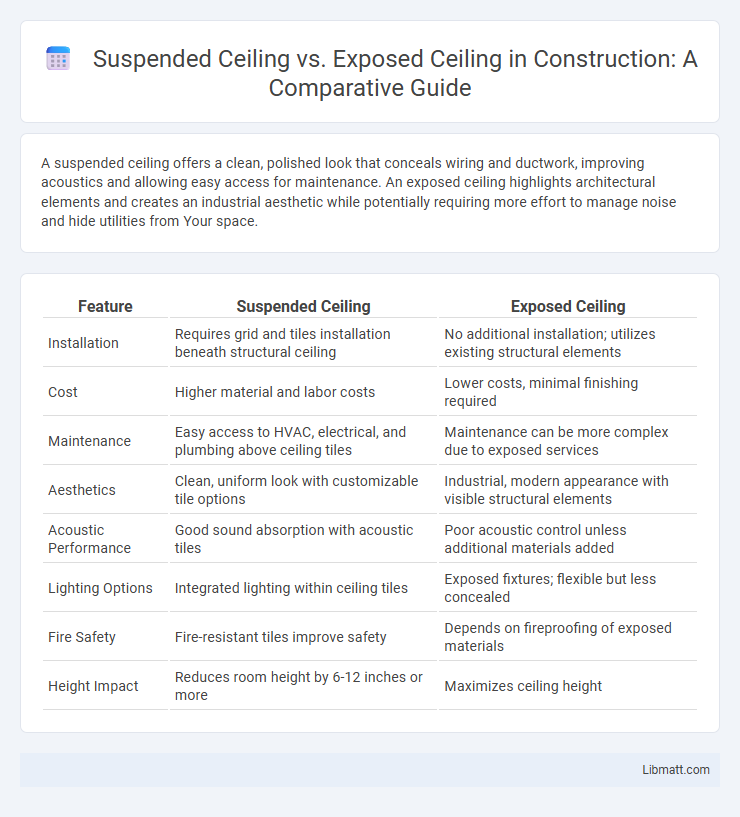A suspended ceiling offers a clean, polished look that conceals wiring and ductwork, improving acoustics and allowing easy access for maintenance. An exposed ceiling highlights architectural elements and creates an industrial aesthetic while potentially requiring more effort to manage noise and hide utilities from Your space.
Table of Comparison
| Feature | Suspended Ceiling | Exposed Ceiling |
|---|---|---|
| Installation | Requires grid and tiles installation beneath structural ceiling | No additional installation; utilizes existing structural elements |
| Cost | Higher material and labor costs | Lower costs, minimal finishing required |
| Maintenance | Easy access to HVAC, electrical, and plumbing above ceiling tiles | Maintenance can be more complex due to exposed services |
| Aesthetics | Clean, uniform look with customizable tile options | Industrial, modern appearance with visible structural elements |
| Acoustic Performance | Good sound absorption with acoustic tiles | Poor acoustic control unless additional materials added |
| Lighting Options | Integrated lighting within ceiling tiles | Exposed fixtures; flexible but less concealed |
| Fire Safety | Fire-resistant tiles improve safety | Depends on fireproofing of exposed materials |
| Height Impact | Reduces room height by 6-12 inches or more | Maximizes ceiling height |
Introduction to Ceiling Types
Suspended ceilings, also known as drop ceilings, consist of a secondary framework hung below the main structural ceiling, offering easy access to utilities and enhanced acoustic control. Exposed ceilings reveal structural elements such as beams, ducts, and pipes, providing an industrial aesthetic and allowing for increased ceiling height. Choosing between suspended and exposed ceilings depends on factors like maintenance convenience, design preferences, and acoustic requirements.
What is a Suspended Ceiling?
A suspended ceiling, also known as a drop ceiling, consists of a metal grid framework suspended below the main structural ceiling, supporting lightweight ceiling tiles or panels. This system conceals wiring, plumbing, and ductwork, providing easy access for maintenance and improving acoustics in commercial and residential spaces. Suspended ceilings enhance aesthetic appeal while offering insulation and soundproofing benefits compared to exposed ceilings.
What is an Exposed Ceiling?
An exposed ceiling is a design choice where structural and mechanical elements such as beams, ductwork, pipes, and electrical conduits remain visible rather than being hidden by a suspended ceiling. This style highlights the building's architectural features and creates an industrial or modern aesthetic commonly used in commercial spaces and loft apartments. Exposed ceilings can improve ceiling height and provide easier access for maintenance compared to suspended ceilings.
Aesthetic Differences and Design Impact
Suspended ceilings offer a sleek, uniform appearance that conceals structural elements and allows for integrated lighting and HVAC systems, enhancing a clean and controlled design aesthetic. Exposed ceilings provide an industrial, open look by showcasing beams, ductwork, and piping, creating visual interest with textures and varying materials that appeal to modern and loft-style interiors. The choice between suspended and exposed ceilings significantly influences spatial perception, lighting dynamics, and the overall ambiance of commercial and residential spaces.
Acoustic Performance Comparison
Suspended ceilings offer superior acoustic performance by incorporating sound-absorbing materials that reduce noise levels and improve speech clarity in a room. Exposed ceilings typically reflect sound more, leading to increased reverberation and potential noise distractions, especially in open or large spaces. Choosing a suspended ceiling enhances your environment's acoustic comfort by minimizing echo and controlling sound transmission effectively.
Cost Implications: Installation and Maintenance
Suspended ceilings typically involve higher initial installation costs due to materials and labor but offer easier access for maintenance, reducing long-term expenses. Exposed ceilings have lower upfront costs since they require minimal materials and labor, but maintenance can be more challenging and costly due to direct exposure of mechanical and electrical systems. Evaluating total cost implications requires comparing installation complexity with ongoing access and repair needs.
Energy Efficiency and Insulation
Suspended ceilings enhance energy efficiency by providing an additional barrier that reduces heat loss, improving insulation and lowering heating and cooling costs. Exposed ceilings lack this extra layer, often resulting in higher energy consumption due to heat transfer through the open space. Effective insulation in suspended ceilings helps maintain consistent indoor temperatures and contributes to overall sustainability in building design.
Accessibility for Repairs and Modifications
Suspended ceilings offer superior accessibility for repairs and modifications by allowing easy removal of individual tiles, enabling quick access to wiring, plumbing, and HVAC systems hidden above. Exposed ceilings, while visually appealing, often require more effort and time to access utilities, as components are fully visible but not designed for easy removal or concealment. You can simplify maintenance with a suspended ceiling without sacrificing the functionality of your space.
Commercial vs Residential Applications
Suspended ceilings are commonly used in commercial settings due to their ability to conceal HVAC systems, wiring, and plumbing while providing sound insulation and easy access for maintenance. Exposed ceilings are often favored in residential applications for their modern, industrial aesthetic and the opportunity to maximize ceiling height and natural light. Commercial spaces prioritize functionality and modularity with suspended ceilings, whereas residential designs lean towards the visual appeal and spaciousness of exposed ceilings.
Choosing the Right Ceiling for Your Space
Suspended ceilings offer improved acoustics, easy access to utilities, and a clean, uniform appearance, making them ideal for offices and commercial spaces. Exposed ceilings create an industrial aesthetic with higher ceilings and better ventilation, suited for modern lofts, studios, and creative environments. Selecting the right ceiling depends on factors like maintenance needs, design preferences, and the function of the space.
Suspended ceiling vs exposed ceiling Infographic

 libmatt.com
libmatt.com